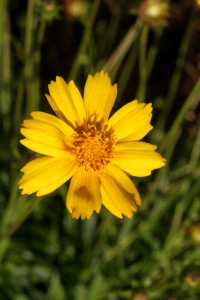A beautiful wildflower that lines the roads and open areas is one of my favorite native pollinating plants. Coreopsis also commonly known as Tickseed was designated our Florida State Wildflower in 1991. It can be found throughout Florida and all 17 species occur in North Florida. Varieties such as Leavenworth’s Swamp (C.nudata), Florida (C. floridana) and Coastalplain (C. gladiata) are found in moist areas and other varieties like Lanceleaf Tickseed (C. lanceolata) and Goldenmane Tickseed (C. basalis) are commonly found in the drier areas of the landscape.
All the varieties of Tickseeds have daisy-like flowers with yellow petals except for the Swamp Tickseed which is more pinkish purple in color. The flower gets its common name by the appearance of the small ovalish seed that has two short spines at one end and looks like a ‘tick’. The most common coreopsis is Coreopsis leavenworthii. This plant can be found in moist pinelands and disturbed sites. You can spot the blooms of bright yellow ray petals with brownish central disk flowers from late spring through late fall. This coreopsis can reach 3 feet in height. It grows like a weed and can quickly establish itself on bare soil. Coreopsis is essentially an annual with our colder winters but produces many seeds that will multiply as long as the plant receives adequate sun and moisture. A special species of coreopsis found only here in the Panhandle is the Chipola coreopsis (C. integrifolia). It is less common and only found along the Chipola River. This 18-24” plant has deep green oval-shaped leaves and deep yellow flowers seen blooming in the Fall, maybe a great time to go kayaking or hiking along the river! The Chipola coreopsis prefers moist soils and some protection from the sun. This variety is so rare that it has been listed endangered by the Florida Department of Agriculture.
Coreopsis is pollinated mostly by small bees and not visited as much by butterflies and other pollinators. They are a great plant to use for a show of color! You can get seeds from your local garden center or from the Florida Wildflower Growers Cooperative (https://floridawildflowers.com). This Florida-Friendly plant is drought tolerant and can be sown anytime from October to January.
Sources:
https://www.flawildflowers.org/wp-content/resources/pdfs/Publications/AboutCoreopsis.pdf
https://gardeningsolutions.ifas.ufl.edu/plants/ornamentals/coreopsis.html
- Steps to Keeping a Healthy Lawn - March 30, 2023
- Companion Planting: What is it? - February 21, 2023
- Educational Opportunity: Fruit and Vegetable Meeting - December 22, 2022


